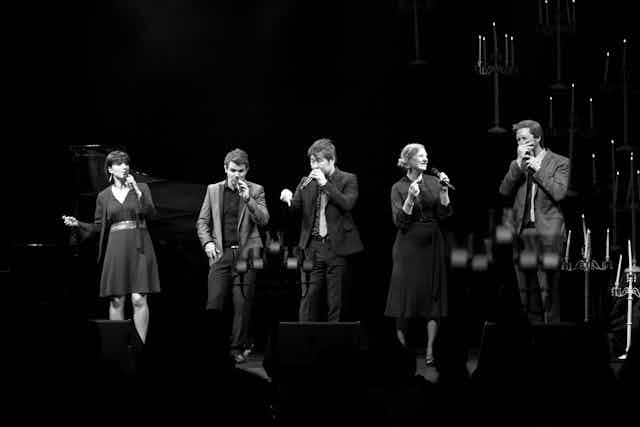Five singers walk on stage and with incredible precision and vocal energy launch into an a capella rendition of Michael Jackson’s Wanna Be Startin’ Somethin, backed by a brilliant but unseen percussionist.

This is what someone walking into the Dunstan Playhouse at Adelaide’s Cabaret Festival might have imagined they were witnessing if they had not read the program or seen the advance publicity for this stunning, virtuosic display of pulsating musical intensity. It was, in fact, created by the a capella group The Idea of North and Kaichiro Kitamura, surely the world’s foremost human beat box.
So seamless was the collaboration between Australia’s renowned a capella ensemble and Japan’s percussive treasure in this world premiere of “Groove Sessions,” that it was impossible at first for the brain to accept that a full percussion section was being generated by Kitamuru. He appeared to be conducting the “beats” through his movements.
Equally inconceivable, as the diverse program unfolded, was the idea that the group could have existed for so many years without the addition of Kitamura’s percussive gifts, so organically connected were they to the blended sounds of the group’s four singers.
Formed in the 1990s, the group’s members, Nick Begbie (tenor), Trish Delaney-Brown (soprano), Naomi Crellin (alto) and Luke Thompson (bass) performed a program that ranged from Cold Chisel to Gershwin, from Charlie Chaplin to Samba. Seriously.
One early surprise was a Jack O’Hagan medley. Anyone under say, 80, might be forgiven for not knowing that O’Hagan was the composer of two huge hit songs, Along the Road to Gundagai (1922) and Our Don Bradman (1930). With lyrics such as “Our Don Bradman – As a batman he can sure lay on the wood” or his better-known paean to the blue gums along the road back to the “old bush home” of Gundagai, one might well wonder what such songs have to say to us today.
But these were the jazz club standards of their time, and in the hands of the group’s able musical director Crellin, they conjured that era, while giving us not sappy nostalgia, but rather much joy.
One of the many vocal gifts that distinguishes this group from others is their ability to generate instrumental sounds. In a brilliant sequence, they captured the subtle shifts of a muted trumpet in a classic jazz solo. In their next number, they captured the brazen sounds of a cuckoo clock in a playful rendition of the German children’s song, Mein Hut, der hat drei Ecken (My hat it has three corners).
Near the mid-point of the show, Kitamura was given the stage to demonstrate how he does what he does. What appears to be effortless is, in fact, highly technical and connected to breath. He showed us how he needs to breathe in while generating the sound of a snare drum, placing breath differently to voice a bass drum or the sound of a “high hat” cymbal. Then he combined and layered the sounds in ways that seem impossible.
Not stopping there, he brilliantly recreated extended sound sequences of an aircraft taking off, a vacuum cleaner and a semi-automatic washing machine, offering us a bit of unexpected comic business.
The willingness of the group to reveal the “tricks of the trade” continued when a volunteer from the audience “conducted” all five in the Joni Mitchell classic Yellow Taxi (1970) with the famous lines, “They paved paradise and put up a parking lot.”
As the volunteer cued each voice on and off, one was again struck by not just the versatility and technical mastery of this group, but the fact that they were simply having fun. And fun, especially when so well-crafted, is contagious. The audience was clearly infected, taking it out into the streets to warm up a crisp, winter night.
This article has been updated to correct the name of one of the performers in The Idea of North.

